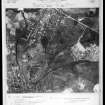Renfrew Airfield
Airfield (20th Century), Military Airfield (Second World War), Military Airfield (First World War)
Site Name Renfrew Airfield
Classification Airfield (20th Century), Military Airfield (Second World War), Military Airfield (First World War)
Alternative Name(s) Moor Park Aerodrome
Canmore ID 94956
Site Number NS56NW 79
NGR NS 5040 6588
NGR Description Centred NS 5040 6588
Datum OSGB36 - NGR
Permalink http://canmore.org.uk/site/94956
- Council Renfrewshire
- Parish Renfrew (Renfrew)
- Former Region Strathclyde
- Former District Renfrew
- Former County Renfrewshire
Renfrew (Moorpark) aerodrome was in two parts. The larger was an Aircraft Acceptance Park (a military base to which aeroplanes were delivered by their manufacturers for testing, and for the fitting of instruments and guns); the smaller, to the west, was an Aircraft Repair Depot. The two sites had separate entries in the 1918 RAF survey of aerodromes.
The Aircraft Acceptance Park covered an area of 48 hectares, measuring 823m by 594m, with its technical buildings and accommodation near the northern boundary. Fife (2007) suggests that construction was well under way in the summer of 1917 and the aerodrome may have already been in use the previous year. Delve (2010) suggests that the field may have been used for flying as early as 1912. There were 11 aeroplane sheds, the largest being 61m by 18m, the smallest 42m by 18m, and a full range of stores and workshops. The military establishment of the aerodrome was 282, of whom 67 were women. The RAF survey of aerodromes noted the types of aircraft it was receiving, and from which manufacturers. There were three types of land-based aircraft - Camel fighters from the British Caudron Company, and DH9s and FE2Bs from Weir. The Park also received three types of ship-based aircraft – 2F1 type from Beardmore, Fairey Type 3 from the Fairey Company, and Torpedo Planes from Fairfield. The Park had a throughput of about 50 aeroplanes a month.
Both the Park and Depot had closed by 1920 but the aerodrome operated for civilian flying in the 1920s, and was the base of No. 602 Auxiliary Squadron from 1925 to 1933. It was re-used in the Second World War and became Glasgow’s main civil aerodrome, until it closed in 1966. Both sites have been completely over-built by industry, housing and a motorway.
Information from HS/RCAHMS World War One Audit Project (GJB) 31 May 2013
NS56NW 79.00 Centred 5040 6588
NS56NW 79.01 c.NS.5000 6605 Pillbox
NS56NW 79.02 c.NS.5079 6588 Pillbox
NS56NW 79.03 c. NS 5012 6543 Pillbox
NS56NW 79.04 NS 50604 66119 Pillbox
This airfield was found to be generally unsatisfactory during WWII, being too small, too near the Glasgow balloon barrage and often enveloped in industrial smoke. Without hard runways, the numbers of aircraft using the field overtaxed the boggy surface.
The problem of confusion for pilots between Abbotsinch airfield (NS46NE 43) and Renfrew was solved when the latter closed on May 2 1966. The main runway was incorporated into the M8 motorway and a large housing estate (Arkleston) has now been built on the site.
D J Smith 1983
This World War I and II airfield has now been subsumed into the M8 motorway and a large housing estate. Some wartime buildings survive.
J Guy 2001; NMRS MS 810/11, Part 3, 214-15
Project (March 2013 - September 2013)
A project to characterise the quantity and quality of the Scottish resource of known surviving remains of the First World War. Carried out in partnership between Historic Scotland and RCAHMS.






















